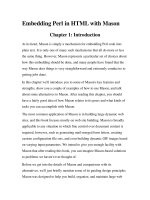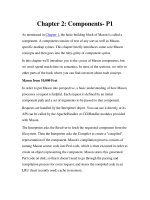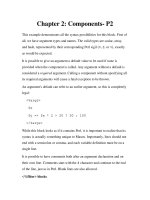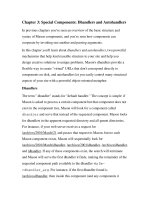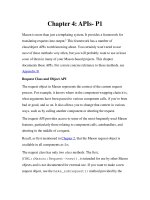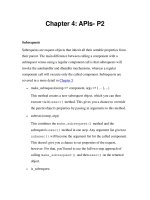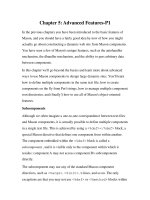Tài liệu Embedding Perl in HTML with Mason Chapter 7: Using Mason with mod_perl pptx
Bạn đang xem bản rút gọn của tài liệu. Xem và tải ngay bản đầy đủ của tài liệu tại đây (55.39 KB, 22 trang )
Chapter 7: Using Mason with mod_perl
While Mason can be used in any text generation context, it is most
frequently used to create dynamic web sites. As you probably know,
executing Perl (or anything else for that matter) as a CGI can be very slow.
Mason, because it is not a small amount of code, can be sluggish when run
as a CGI under heavy loads.
To that end, Mason has been designed to play nice when run under
mod_perl. In fact, Mason has quite a number of features that make it
nicely suited to running under mod_perl.
This chapter assumes that you are familiar with Apache, particularly
Apache's configuration files, and with mod_perl. If you're not, here's a
teaser: mod_perl embeds a Perl interpreter inside the Apache web server.
Because Perl is already loaded, no external processes need to be launched to
serve Perl-generated content. mod_perl also allows many server tasks to
be configured and executed using Perl, which can be a great convenience.
More information on Apache can be found via the Apache web site at
as well as in O'Reilly's Apache: The Definitive
Guide, 3rd Edition (Ben and Peter Laurie, 2003).
For more information on mod_perl, the mod_perl site at
is useful, as is Stas Bekman's fabulous mod_perl
guide, which can be found at the same location. Also useful is Writing
Apache Modules with Perl and C (the "Eagle Book") by Lincoln Stein and
Doug MacEachern, also published by O'Reilly.1 Despite the title, it is really
primarily about mod_perl.
A recent book from Sams Publishing, The mod_perl Developer's Cookbook
by Geoffrey Young, Paul Lindner, and Randy Kobes, is also an extremely
valuable resource for anyone who's going to spend a significant amount of
time working with mod_perl. It fills a different niche in the developer's
mental toolkit.
With Apache 2.0 and mod_perl 2.0 on the horizon as this is being written,
please note that this chapter assumes that you are using Apache 1.3.x and
mod_perl 1.22 or greater. In addition, your mod_perl should have been
compiled with PERL_METHOD_HANDLERS=1 and
PERL_TABLE_API=1, or with EVERYTHING=1 .
We expect Mason to work immediately under the 1.x compatibility layer
that mod_perl 2.0 will provide. And of course, once mod_perl and
Apache 2.0 are out, we hope to find new features for Mason to exploit.
Configuring Mason
Mason can be configured under mod_perl in two different ways. The
easiest of the two merely requires that you add a few directives to Apache's
configuration files. This method is very easy to use and is appropriate for
most uses of Mason. It's commonly called "configuration via httpd.conf,"
though many configuration directives can be placed anywhere Apache will
see them, such as in an .htaccess file.
The other way is to write a custom piece of Perl code to bind Mason and
mod_perl together, which you instruct mod_perl to use when handling
requests. This method is very flexible but is a bit more complicated. It is not
usually necessary, but it can be useful for a particularly complex or dynamic
configuration. This configuration method is commonly called "configuration
via a handler.pl," though the handler.pl file can be called anything you like.
For simplicity's sake, we always refer to the httpd.conf and handler.pl files
throughout the book.
Configuration via httpd.conf
To make Mason work under mod_perl, we need to set up a few Mason
configuration variables and then tell mod_perl to use Mason as a
PerlContentHandler . Here is the simplest possible configuration:
SetHandler
perl-script
PerlHandler
HTML::Mason::ApacheHandler
The SetHandler directive just tells Apache to use mod_perl for this
request. The PerlHandler directive is provided by mod_perl, and it
tells Apache that the given module is a content handler. This means that the
module will respond to the request and generate content to be sent to the
client.
Putting the previous snippet in your configuration file will cause every file
your web server processes to be handled by Mason. This is probably not
what you want most of the time, so let's narrow it down a bit:
<Location /mason>
PerlSetVar
MasonCompRoot
/path/to/doc/root/mason
SetHandler
perl-script
PerlHandler
HTML::Mason::ApacheHandler
</Location>
This tells Apache that only requests that have a path starting with /mason
will be handled by Mason. We've narrowed down the component root
correspondingly, though this is not required. In fact, it's important to realize
that component root and document root are not the same thing. There will be
Alternately, we might want to specify that only certain file extensions will
be handled by Mason:
AddType
text/html
.mhtml
<LocationMatch "\.mhtml$">
SetHandler
perl-script
PerlHandler
HTML::Mason::ApacheHandler
</LocationMatch>
The first directive tells Apache that files ending with .mhtml have a contenttype of text/html . The LocationMatch section says that all URIs
ending with .mhtml will be handled by Mason. This configuration is
convenient if you want to intermix Mason components with other types of
content, such as static HTML or image files, in the same directory. You
want Mason to process only the Mason components, as having it process
images or CSS is both a waste of time and a possible source of errors. Who
knows what Mason will make of an image's binary data? You probably don't
want to find out.
By default Mason will use the server's document root for the resolver's
comp_root parameter. Mason also needs a data directory to store things
like compiled components and cache files. By default, this will be a
subdirectory called mason under your server's ServerRoot. It is important
that this directory be writable by the user or group ID that the Apache
children run as, though the ApacheHandler will ensure that this happens if
your server is started as the root user.
Both of these defaults can easily be overridden.
PerlSetVar
MasonCompRoot
/var/www/comps
PerlSetVar
MasonDataDir
/var/mason-data-dir
The PerlSetVar directive sets variables that are accessible by Perl
modules via the Apache API. Mason uses this API internally to get at these
settings.
All of the Interp, Compiler, and Lexer parameters that were discussed in
Chapter 6 can be set from the configuration file. A full listing of all the
variables that can be set via PerlSetVar directives can be found in
Appendix B.
You also may have multiple Mason configurations for different parts of your
web server:
<VirtualHost 1.2.3.4>
ServerName
DocumentRoot
www.example.com
/home/example/htdocs/
PerlSetVar
MasonCompRoot
/home/example/htdocs
PerlSetVar
MasonDataDir
/home/example/mason-
data
<LocationMatch "\.mhtml$">
SetHandler
perl-script
PerlHandler
HTML::Mason::ApacheHandler
</LocationMatch>
</VirtualHost>
hello-kitty-heaven.example.com
DocumentRoot
PerlSetVar
/home/hello-kitty/htdocs/
MasonCompRoot
/home/hello-
kitty/htdocs/mason
PerlSetVar
MasonDataDir
/home/hello-
kitty/mason-data
<LocationMatch "\.mhtml$">
SetHandler
perl-script
PerlHandler
HTML::Mason::ApacheHandler
</LocationMatch>
</VirtualHost>
In this case, Mason will find the relevant configuration directives when
asked to handle a request.
When you have only a single Mason configuration for your server, Mason
will attempt to create the objects it needs as early as possible, during the
initial server startup.
Doing this increases the amount of shared memory between Apache
processes on most systems. The reason is that memory that is not modified
after a process forks can be shared between a parent and any children it
spawns, at least with some operating systems.
Configuration via Custom Code
When simple configuration variables aren't enough, when you simply must
do it the hard way, Mason has an alternative. Write your own code. This
method gives you complete control over how Mason handles requests at the
cost of a bit of extra code to maintain.
The simplest external script that would work might look something like this:
package MyMason::MyApp;
use strict;
use HTML::Mason::ApacheHandler;
use Apache::Request;
my $ah =
HTML::Mason::ApacheHandler->new
( comp_root => '/home/httpd/html',
data_dir
=> '/home/httpd/mason' );
sub handler {
my $r = shift;
# Apache request object;
return $ah->handle_request($r);
}
Assume that this file is saved in the Apache configuration directory as
handler.pl.
Then you'd add a few configuration directives to your Apache configuration
file:
PerlRequire
handler.pl
<LocationMatch "\.mhtml$">
SetHandler
perl-script
PerlHandler
MyMason::MyApp
</LocationMatch>
Notice the lack of PerlSetVar directives this time. Also note that the
value given to the PerlHandler directive is now the package you
declared in the handler.pl file. This combination of script and Apache
configuration would give us the exact same results as in the previous section.
Let's go through this in more detail to understand exactly what it is doing.
Starting with the Apache configuration piece, we see that we set
PerlHandler to MyMason::MyApp. This tells mod_perl to look for a
subroutine called handler() in the MyMason::MyApp namespace.
Mason does not include any such thing, so we have to write it ourselves,
which is what the script does.
The choice of naming it MyMason::MyApp is completely arbitrary. You
might prefer something that identifies the project you're working on, like
GooberCorp::WebEmail::Mason or something like that. It doesn't
even need to have the word Mason in it, though it will probably improve the
clarity of your httpd.conf file if it does.
Why are we declaring ourselves as being in the MyMason::MyApp
namespace? Look at our PerlHandler directive. It indicates that the
handler subroutine will be found in that same namespace.
The first few lines of the script are simple. The only module that must be
loaded is HTML::Mason::ApacheHandler.
To save some memory, we load Apache::Request in this file. Mason
would load this for us when it was needed, but we want to make sure it gets
loaded during the server startup so memory can be shared.
Then we create the HTML::Mason::ApacheHandler object. This
object takes an Apache request object and figures out how to dispatch it to
Mason.
This object contains an HTML::Mason::Interp object. As we discussed
in the previous chapter, when a Mason object contains another Mason
object, you can pass parameters to the containing object's constructor that
are intended for the contained object(s).
This means that parameters that are intended for the Interpreter object's
constructor can be passed to the ApacheHandler's new() method. In
addition, since the Interpreter contains a Resolver, Compiler, and so forth,
you can also pass parameters for those objects to the ApacheHandler
constructor.
The handler() subroutine itself is quite simple. The Apache request
object is always passed to any handler subroutine by mod_perl. This
object is then passed to the ApacheHandler object's handle_request()
method. The handle_request() method does all the real work and
makes sure that content is sent to the client. Its return value is a status code
for the request and the handler() subroutine simply returns this status
code to mod_perl, which passes it onto Apache, which handles it however
it is configured to do so.
If this were all we did with a handler subroutine it would be awfully
pointless. Let's examine a more complicated scenario.
We can rewrite the earlier virtual hosting example to use an external script:
PerlRequire
handler.pl
<VirtualHost 1.2.3.4>
ServerName
www.example.com
<LocationMatch "\.mhtml$">
SetHandler
perl-script
PerlHandler
MyMason::MyApp
</LocationMatch>
</VirtualHost>
<VirtualHost 1.2.3.4>
ServerName
hello-kitty-heaven.example.com
<LocationMatch "\.mhtml$">
SetHandler
perl-script
PerlHandler
MyMason::MyApp
</LocationMatch>
</VirtualHost>
That takes care of the Apache configuration file; now the script:
package MyMason::MyApp;
use strict;
use HTML::Mason::ApacheHandler;
use Apache::Request;
my %host_to_comp_root =
( 'www.example.com' =>
'/home/example/htdocs',
'hello-kitty-heaven.example.com' =>
'/home/hello-kitty/htdocs' );
my %ah;
sub handler {
my $r = shift;
# Apache request object;
my $host = $r->hostname; # tells us what
server was requested;
my $comp_root = $host_to_comp_root{$host};
# create a new object for this host if none
exists yet.
$ah{$host} ||=
HTML::Mason::ApacheHandler->new(
comp_root => $comp_root );
return $ah{$host}->handle_request($r);
}
This is a rather simple example and doesn't necessarily justify writing a
script rather than just configuring via the Apache configuration file.
However, let's imagine that we also had the script check in each home
directory for extra
Mason configuration directives, which could be stored either as pure Perl or
in a specified format.
How about if you had to do virtual hosting for 200 domain names? Then
some sort of scripted solution becomes more appealing. Of course, you
could always write a script to generate the Apache configuration directives
too. It really depends on what your needs are. But Mason gives you the
flexibility to handle it in the way you think best.
Document Root Versus the Component Root
Apache's document root is what defines the top level web directory of your
Apache configuration. For example purposes, let's assume a document root
of /home/httpd/htdocs. If you request the document /index.html via your web
browser, Apache will look for the file /home/httpd/htdocs/index.html. If
index.html contains an HREF to /some/file.html, you would have to place a
file at /home/httpd/htdocs/some/file.html for the link to be resolved properly.
Mason has a component root, which is somewhat similar. If Mason's
component root is /home/httpd/htdocs/mason, and a component makes a
component call with an absolute path of /some/component, Mason will look
for a file at /home/httpd/htdocs/mason/some/component.
It can be confusing when the component root and the document root are not
the same because this means that the path for an HREF and a component
path, though they may appear to be the same, can point to two different files.
For example, with the preceding configuration, we have the following:
<a href="/some/file.html">resolves to
/home/httpd/htdocs/some/file.html</a>.
<& /some/file.html &> resolves to
/home/httpd/htdocs/mason/some/file.html.
Do you see the difference?
Be sure to keep this in mind while working on your components. To avoid
dealing with this problem, you could simply make your document root and
component root the same directory and decide whether or not something is a
component based on its file extension.
This is generally a bit easier on the brain and is definitely what we
recommend for first-time Mason users.
Not OK
By default, if a component does not give an explicit return code, the
ApacheHandler object will assume that the request was error free and that
the status it should return is OK. But sometimes things are just not OK.
For example, we may want to give an authorization error or a document not
found error. There are several ways of doing this.
The first is to have the component that is called return the desired status
code. Inside the handle_request() method, the ApacheHandler object
checks to see if the component that it called returned a value. If so, it uses
this as the status code for the request.
If you try to do this, remember that with autohandler wrapping, the last
component executed is not necessarily the first one called. For example, let's
assume a component called /give_up.html:
<%init>
# I give up!
use Apache::Constants qw(NOT_FOUND);
return NOT_FOUND;
</%init>
This component could be wrapped by an /autohandler like this:
<html>
<head>
<title>My wonderful site</title>
</head>
<body>
% $m->call_next(%ARGS);
</body>
</html>
In this case the return code from the /give_up.html component ends up being
ignored.
A better way to do this is to use the Mason request object's abort()
method, which we covered in Chapter 4. Using the abort() method, we
could rewrite /give_up.html like this:
<%init>
# I give up!
use Apache::Constants qw(NOT_FOUND);
$m->abort(NOT_FOUND);
</%init>
Any value passed to abort() will eventually be passed to the client. But
this still might not work. The problem is the text content in the /autohandler
that is generated before /give_up.html is called. Mason sees this before
abort() is called and will try to send it to the client. This may be a
problem for some non-OK codes, particularly for redirects. We need to clear
Mason's buffer in order to make sure that the client doesn't see any output
before the error is generated.
<%init>
# I really give up!
use Apache::Constants qw(NOT_FOUND);
$m->clear_buffer;
$m->abort(NOT_FOUND);
</%init>
This will work just fine for all return codes, though some may need
additional manipulation of the Apache object, $r, depending on the status
code being returned.
$r
Every component that is run under Apache via the ApacheHandler module
has access to a global variable called $r . This variable is the Apache
request object for the current request. Using this variable gives you access to
the full Apache API, including the ability to set HTTP headers, send
messages to the Apache logs, access Apache configuration information, and
much more.
If you used the Apache::Request module to processing incoming
arguments, which is Mason's default, then $r will actually be an
Apache::Request object.
Documenting what you can do with this object is outside the scope of the
book, but do not despair. The mod_perl resources mentioned at the
beginning of this chapter, as well as the Apache object's documentation (run
perldoc Apache, and if you set args_method to mod_perl , also
perldoc Apache::Request), can tell you everything you need to
know. It's worth looking at the documentation to get an idea of what kinds of
things it's capable of doing.
ApacheHandler Parameters
The ApacheHandler object can take several parameters to its constructor; all
of them are optional:
•
args_method => 'mod_perl' or 'CGI'
This tells the object what module you would like it to use for parsing
incoming query string and POST parameters. CGI indicates that you
want to use CGI.pm and mod_perl indicates that you want to use
Apache::Request. Apache::Request is faster, uses less
memory, and is the default.
You may choose to use CGI.pm if you want to take advantage of its
form element generation features or if you cannot use
Apache::Request on your operating system.
•
decline_dirs => $boolean
By default, requests that match directories under a Location or
Directory section served by Mason are declined, returning a status
code of DECLINED (-1) so that Apache will handle directory
requests as it normally does. If you would like to handle these
requests with Mason, presumably via a dhandler, you should set this
to false.
Obviously, if you told Apache to serve Mason requests based only on
a file extension, this parameter is not likely to be meaningful.
•
apache_status_title => $string
The ApacheHandler object will register itself with mod_perl's
Apache::Status module if possible. This registration involves
giving Apache::Status a unique title for the registered object.
This defaults to "HTML::Mason status" but if you have multiple
ApacheHandler objects you may want to give each one a unique title.
Otherwise, only one will be visible under the Apache::Status
display.
The ApacheHandler module provides a special subclass of the Request
object $m. This object has an additional constructor parameter besides those
available to normal requests:
•
auto_send_headers => $boolean
This tells Mason whether or not you'd like it to automatically send the
HTTP headers before sending content to a client. By default, this is
true, and Mason will call $r->send_http_header() before
sending output to the client. If you turn this off, you will need to send
the headers yourself.
If you do call the send_http_header() method yourself before
Mason has a chance to do so, Mason will not send extra headers,
regardless of the value of this variable.
Remember, you can simply pass this value to the ApacheHandler
object when you create it, or you can set
MasonAutoSendHeaders in your httpd.conf file.
To Autoflush or Not to Autoflush
In Chapter 4 we saw that autoflushing can be turned on and off for a request.
Whether or not autoflushing is turned on has a big impact on what kind of
things you can do while running under Apache.
With autoflush off, you can easily start generating content, have your code
throw it away halfway through, and then issue a redirect. This will simply
not work with autoflushing on.
For a redirect to work, it has to have a chance to set the headers. Since
content is sent as soon as it is created when autoflushing, any redirects that
happen after content is generated will happen after the headers have already
been sent. This makes it harder to have a flexible application with
autoflushing on, and for this reason most people do not use it.
Turning autoflush on can make the response time appear quicker, since the
initial output gets to the client sooner. To get the best of both worlds, leave
autoflushing off and send quick status reports with $m->flush_buffer
on the pages that need it.
Generating Something Besides HTML
Eventually you may want to have Mason generate things besides HTML,
such as plain text pages, MP3 playlists, or even images. This is quite easy to
do. Here's a simple component that generates plain text:
I am a piece of plain text.
So boring.
This
will not be <b>bold</b>.
<%init>
$r->content_type('text/plain');
</%init>
If you want to generate binary data, you have to be careful to make sure that
no extraneous snippets of text sneak into it:
<%args>
$type => 'jpeg'
</%args>
<%init>
use Apache::Constants qw(OK);
$m->clear_buffer; # avoid extra output (but it
only works when autoflush is off)
my $img = make_image( type => $type ); # magic
hand-waving ...
$r->content_type("image/$type");
$r->send_http_header;
$m->print($img);
$m->abort(OK);
# make sure nothing else gets
sent
</%init>
This component does two things to ensure that nothing corrupts the image's
binary data. First, it clears the buffer, because if this component was
wrapped by an autohandler there could be some text in the buffer when it is
called. Of course, if you've turned on autoflushing, the clear_buffer()
method doesn't actually do anything, so you'd have to be extra careful in that
situation.
Then, after sending the image, the component flushes the buffer to make
sure that output gets sent and then aborts to make sure that nothing gets sent
afterward. By passing the OK status code to the abort() method, we make
sure that the correct status code makes its way to the client. The abort()
method does not prevent output from being sent to the client, so the image is
sent as we'd expect.
We put all this code in an <%init> block to make sure that it gets executed
right away, before any whitespace from the rest of the component could be
processed as output.
Note that Mason's templating capabilities aren't exactly taking center stage
in this example. You may ask why Mason is being used in this situation at
all. Indeed, without context, it's difficult to see a good reason; however,
people have done just this kind of thing in order to take advantage of
Mason's other features like dhandlers or to integrate the dynamically
generated image into an existing Mason site.
Apache::Status and Mason
As was mentioned earlier, Mason can cooperate with the
Apache::Status module to display information about itself. To enable
this module is relatively simple. For example, if you'd like the module to be
accessible at the URL /perl-status, you could add this to your Apache
configuration:
<Location /perl-status>
SetHandler perl-script
PerlHandler Apache::Status
</Location>
Apache::Status provides information about mod_perl in general and
allows other modules to provide their own status hooks. Mason provides a
basic status report on the ApacheHandler and Interp objects, as well as a list
of which components are currently in the code cache.



